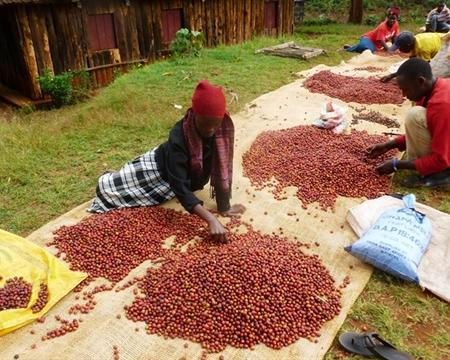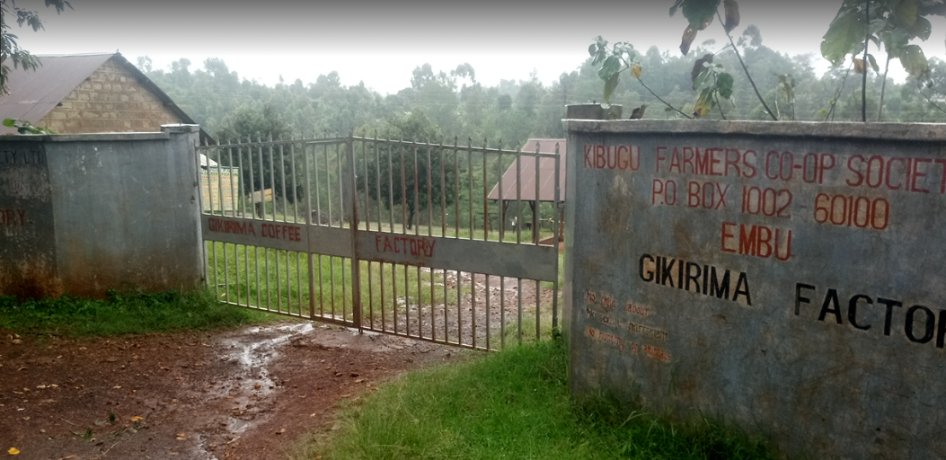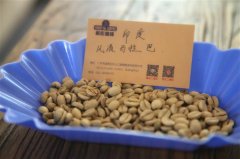Characteristics of planting and processing Flavor of washed Coffee in Kenya brief introduction of Coffee washing and processing Plant gikirima
Africa used to dominate the global coffee market. At the peak of production, African countries accounted for four of the world's top ten coffee producers. Today, African coffee beans still compete in the world coffee market. Kenya is one of the largest exporters of fine coffee on the African continent. Qianjie will take you to learn about the cultivation and processing of coffee in Kenya.
The GIKIRIMA factory is located on the slopes of Mount Kenya, which has the best conditions for growing coffee. The region experienced two seasons of rain, resulting in two seasons of harvest. The main crop is harvested from October to December, and the fly crop is harvested from April to June: 80% of coffee is picked during the main crop and 20% during the fly crop. Small farmers in the surrounding area only pick ripe cherries and transport them to Gikirima, where they are starched and fermented overnight in pots. The coffee is then washed and placed on a raised drying bed, where it can be kept for an average of 7-15 days, depending on the weather. Coffee is frequently flipped and sorted when it is dry.

GIKIRIMA is the name of a washing station owned and operated by 1050 kibugu members of Kibigu Co-Op Society. Planted on a hillside in southern Shandong, Kenya, farmers send coffee to Gikirima for weighing, processing and cleaning. Coffee is washed on the day of delivery, then slowly dried and constantly sorted to avoid defects. The cooperative grows a mixture of SL28 and SL34 coffee varieties, as well as other crops, including tea, bananas and corn. Cooperatives also arrange to raise the wages of farmers to cover the cost of education for children in the community.
The Gikirima factory is located in the Manyata branch of the Embu district, near the town of Gicherori and 14 kilometers away from the center of Embu. It belongs to the Kibugu Farmers' Cooperative together with the Kathakwa, Ndunduri, Ngerwe and Gicherori factories. The Gikirima factory now has 1050 active members, each with an average of about 1 hectare of land for growing coffee, as well as tea, macadamia nuts, beans, bananas and corn. The area is 1800 meters above sea level and has deep, well-drained, fertile red volcanic soil with an annual rainfall of 1900 mm. Smallholder members of the factory can receive training and technical advice as well as advance payments for agricultural inputs and tuition fees.

The coffee is carefully selected by smallholder members and then sent to the Kamunyaka plant for pulping.
Gikirima has a long-term goal of increasing coffee production and building transparent, trust-based relationships with smallholder farmers through farmer training, agricultural practice seminars and the provision of up-to-date printed references on sustainable agriculture. Take this coffee bean numbered 11837, for example.
Serial number # 11837
Origin
Kenya
Area
Enbu
Farm
Various smallholder members of the Kibugu Farmers' Cooperative
Kinds
SL-28 、 SL-34
Height
1800 masl
Process method
Water washing
Harvest schedule
October to December (major crops); April to June (fly crops)
Important Notice :
前街咖啡 FrontStreet Coffee has moved to new addredd:
FrontStreet Coffee Address: 315,Donghua East Road,GuangZhou
Tel:020 38364473
- Prev

Why Kenyan coffee beans are sour? Effect of water injection technique on the flavor of brewed coffee
There is no doubt: Kenya is an amazing coffee producer. Coffee from this region is famous for its strong aroma, refreshing acidity, sweet berry flavor, rich taste and clean and lasting aftertaste. Acidity enthusiasts like to test in Kenya cups. In fact, the most frequently asked questions in daily life are
- Next

How to brew Indian monsoon malaba coffee? History of different regions of India Coffee bean flavor differences
Coffee from the Malabar region of southern India is treated by wind and sun, which will be introduced in the next section of the knowledge popularization and introduction. The acidity of this coffee is low and the taste is very special. Here's how to make this type of coffee. Recommended cooking method: hand brewing filter cup: KONO filter cup water temperature: 87-88C powder amount: 15 g powder water ratio: 1:1
Related
- Detailed explanation of Jadeite planting Land in Panamanian Jadeite Manor introduction to the grading system of Jadeite competitive bidding, Red bid, Green bid and Rose Summer
- Story of Coffee planting in Brenka region of Costa Rica Stonehenge Manor anaerobic heavy honey treatment of flavor mouth
- What's on the barrel of Blue Mountain Coffee beans?
- Can American coffee also pull flowers? How to use hot American style to pull out a good-looking pattern?
- Can you make a cold extract with coffee beans? What is the right proportion for cold-extracted coffee formula?
- Indonesian PWN Gold Mandrine Coffee Origin Features Flavor How to Chong? Mandolin coffee is American.
- A brief introduction to the flavor characteristics of Brazilian yellow bourbon coffee beans
- What is the effect of different water quality on the flavor of cold-extracted coffee? What kind of water is best for brewing coffee?
- Why do you think of Rose Summer whenever you mention Panamanian coffee?
- Introduction to the characteristics of authentic blue mountain coffee bean producing areas? What is the CIB Coffee Authority in Jamaica?

